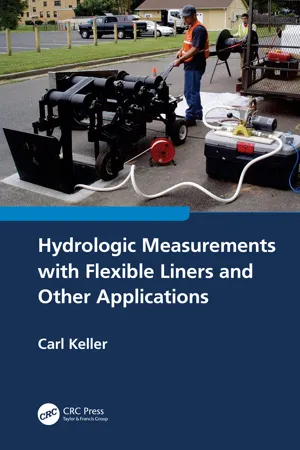
- 308 pages
- English
- ePUB (mobile friendly)
- Available on iOS & Android
Hydrologic Measurements with Flexible Liners and Other Applications
About this book
This book provides hydrologists the information needed for the characterization of contaminated subsurface hydrologic sites. It explains how to seal boreholes, map contaminant distribution in a formation, map the flow zones, and measure the hydraulic head distribution through a single flexible liner. Results of the measurement methods provided demonstrate the reality and reliability of the unique FLUTe techniques. These measurements help to predict contaminant migration and aid in the design of a groundwater remedy. The limitations of several methods are provided to allow an intelligent choice of methods and a well-informed selection of devices among the alternative methods. The mechanics of flexible liner systems are explained with examples of applications beyond the hydrologic measurements such as relining of piping.
Features include:
-
- The first book on a modern technology that is replacing traditional technology globally
-
- Written by the inventor of the FLUTe technology with 25 years' experience with successful applications
-
- Describes FLUTe technology in detail, including the theory behind the tools, how to use the tools, and the mathematics used to interpret the data generated by the tools
-
- Provides step-by-step explanations of how to conduct fieldwork and how to analyze the data gathered
-
- Minimizes reliance on mathematical explanations and uses illustrations and examples that allow readers to understand the technology
This book is of interest to environmental professionals, mine operators, petroleum engineers, geophysicists who use these methods or are considering using these methods for remediation of groundwater contamination, academics, students, and regulators.
Frequently asked questions
- Essential is ideal for learners and professionals who enjoy exploring a wide range of subjects. Access the Essential Library with 800,000+ trusted titles and best-sellers across business, personal growth, and the humanities. Includes unlimited reading time and Standard Read Aloud voice.
- Complete: Perfect for advanced learners and researchers needing full, unrestricted access. Unlock 1.4M+ books across hundreds of subjects, including academic and specialized titles. The Complete Plan also includes advanced features like Premium Read Aloud and Research Assistant.
Please note we cannot support devices running on iOS 13 and Android 7 or earlier. Learn more about using the app.
Information
1Introduction/Purpose
2Brief History of Flexible Liner Underground Technologies (FLUTe) Methods
Table of contents
- Cover Page
- Half-Title Page
- Title Page
- Copyright Page
- Dedication Page
- Contents
- Foreword (by Joe Rossabi)
- Preface
- Acknowledgments
- Author
- List of Abbreviations
- Chapter 1 Introduction/Purpose
- Chapter 2 Brief History of Flexible Liner Underground Technologies (FLUTe) Methods
- Chapter 3 The Mechanics of Flexible Liners
- Chapter 4 Chemistry of the Liners
- Chapter 5 Kinds of Blank Liners
- Chapter 6 Novel Applications of Blank Liners
- Chapter 7 General Advantages of Flexible Blank Liners
- Chapter 8 Hazards to the Liner and Precautions
- Chapter 9 Special Devices Designed for Use with Liners
- Chapter 10 Theory and Application of FLUTe Liner Methods
- Chapter 11 FLUTe Vadose Multi-Level Measurements
- Chapter 12 The TACL (Traveling Acoustic Coupling Liner)
- Chapter 13 Application of Combinations of Liners and Other Methods
- Chapter 14 CSC (Continuous Screened Casing) Design
- Chapter 15 Other Applications of Liners
- Chapter 16 FLUTe Calculational Models
- Chapter 17 Installation Procedures of Many Kinds
- Chapter 18 The Manufacturing Machines and Facilities Developed for Liner Fabrication
- Chapter 19 Conclusion
- References
- Index